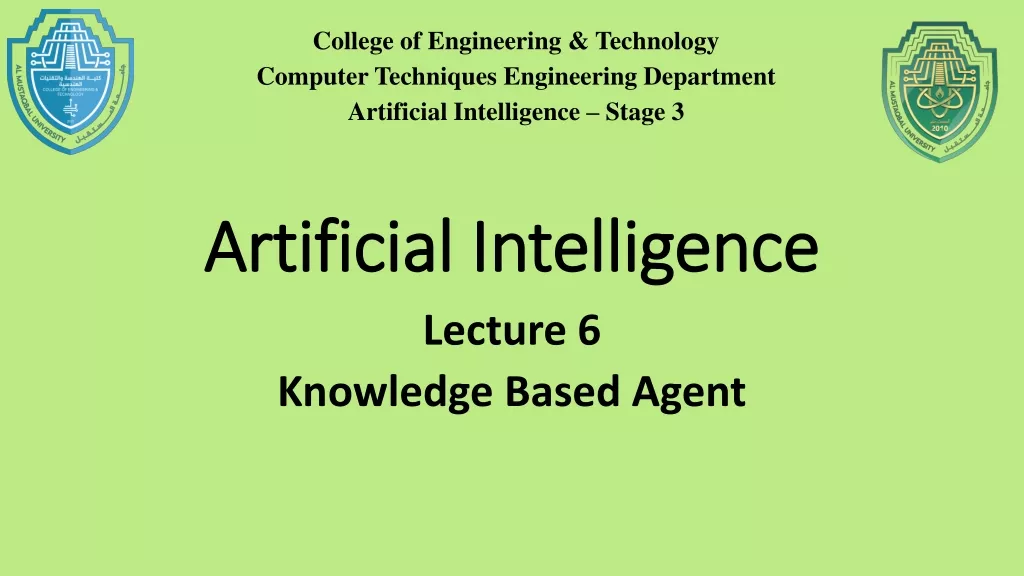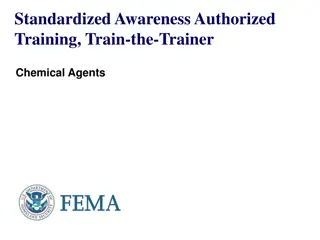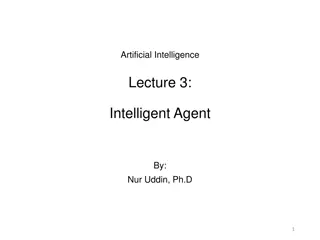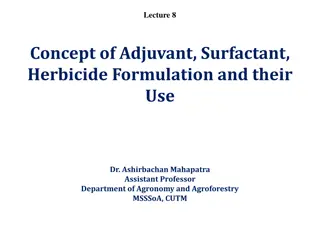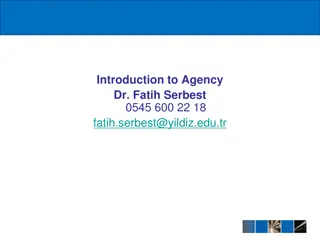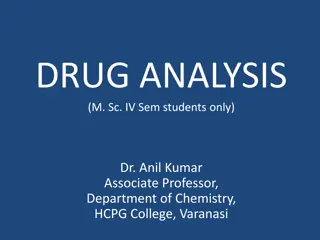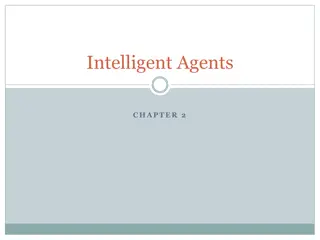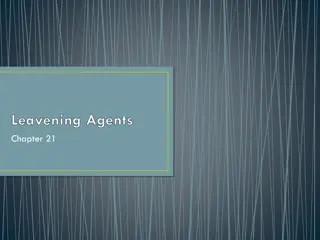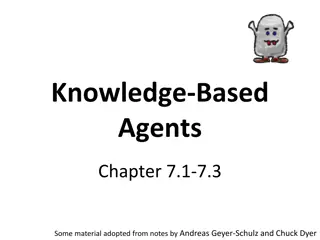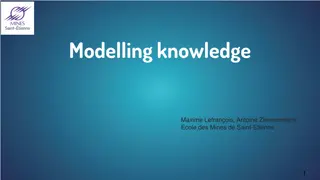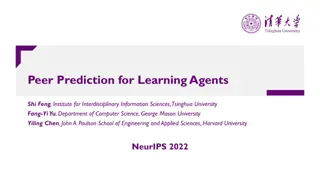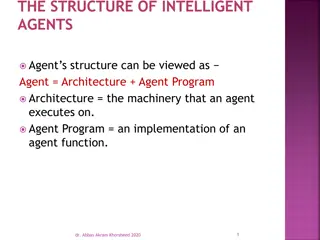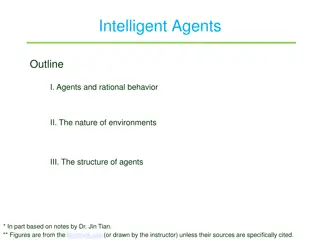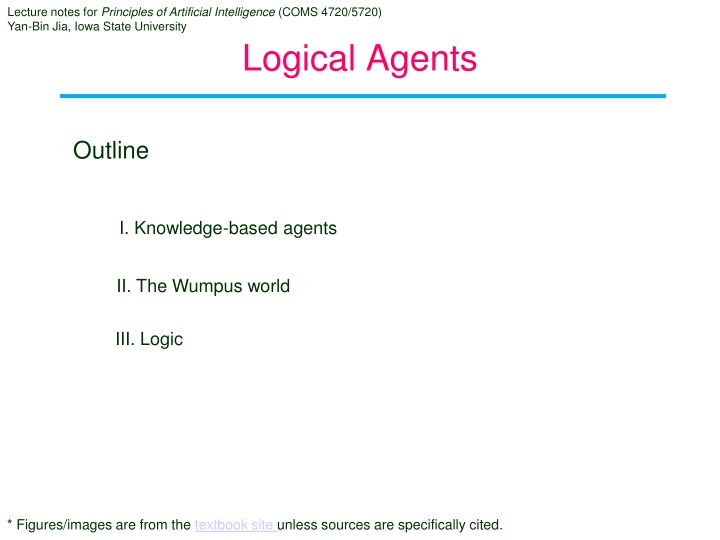
Logical Agents and The Wumpus World Overview
Explore knowledge-based agents in artificial intelligence, featuring problem-solving, utilizing a knowledge base, and understanding logical reasoning. Delve into navigating the treacherous Wumpus World, with pits, a lurking beast, and a quest for gold while facing environmental challenges and employing strategic actuators.
Download Presentation

Please find below an Image/Link to download the presentation.
The content on the website is provided AS IS for your information and personal use only. It may not be sold, licensed, or shared on other websites without obtaining consent from the author. If you encounter any issues during the download, it is possible that the publisher has removed the file from their server.
You are allowed to download the files provided on this website for personal or commercial use, subject to the condition that they are used lawfully. All files are the property of their respective owners.
The content on the website is provided AS IS for your information and personal use only. It may not be sold, licensed, or shared on other websites without obtaining consent from the author.
E N D
Presentation Transcript
Lecture notes for Principles of Artificial Intelligence (COMS 4720/5720) Yan-Bin Jia, Iowa State University Logical Agents Outline I. Knowledge-based agents II. The Wumpus world III. Logic * Figures/images are from the textbook site unless sources are specifically cited.
I. Knowledge-Based Agents Problem solving agents do not know general facts. An 8-puzzle agent does not know that two tiles cannot occupy the same space. Their atomic representations are very limited. e.g., a list of all possible concrete states. Intelligent agents need knowledgeabout the world in order to carry out reasoning for good decision making. Represent states, actions, etc. Incorporate new percepts. Update internal representation of the world. Deduce hidden properties of the world. Deduce appropriate actions.
Knowledge Base A knowledge base (KB) is a set of sentences that represents some assertion about the world. An axiom is such a sentence that is taken to be true without being derived from other sentences. Domain-independent algorithms Inference engine KB Domain-specific content TELL: Add new sentences to the KB. ASK: Query the KB. Inference: Derive new sentences from old.
Generic Knowledge-Based Agent // asks what action // it should perform. // tells what action // was chosen.
II. The Wumpus World Cave consisting of connected rooms. Some rooms contain pits that will trap whoever enters them. The wumpus lurks in one room ready to eat whoever enters the room. The wumpus can be shot by the agent, who has only one arrow. A heap of gold is in a different room than where the wumpus lurks. Cave Goal: Find the gold and bring it back to the start without getting killed.
Task Environment Performance measure +1000 (climbing out of the cave with the gold) 1000 (falling into a pit or being eaten by the wumpus) 1 (each action taken) 10 (using up the arrow) Environment 4 4 grid surrounded by walls [1,1]: the starting square for the agent, who faces east locations of the gold and the wumpus: [1, 1] - otherwise randomly generated under uniform distribution (two distinct locations) - 0.2 probability for a square other than [1,1] and without gold or wumpus to be a pit
Actuators Actuators: 1) Forward, TurnLeft by 90 , TurnRight by 90 Death of the agent if it enters a square containing a pit or a live wumpus. No movement if bumping into a wall. 2) Grab Picks up the gold if it in the same square as the agent. 3) Shoot Fire an arrow in the direction the agent is facing. The arrow continues until hitting the wumpus (who gets killed consequently) or a wall. 4) Climb Climb out of the cave if at [1,1].
Sensors 5 Sensors, each providing one bit of information: 1) Stench in the squares directly (not diagonally) adjacent to the wumpus 2) Breeze in the squares directly (not diagonally) adjacent to a pit 3) Glitter Percepts in the form of a 5-vector: in the square where the gold is e.g., [Stench, Breeze, None, None, None] 4) Bump when the agent walks into a wall 5) Scream when the wumpus is killed
Characteristics of WW Deterministic, discrete, static, and single-agent Outcome specified. The wumpus does not move. Partially observable Locations of the pits and the wumpus are unknown. Challenge: The agent needs to use logical reasoning to overcome its initial lack of knowledge about the environment s configuration.
Solution by a Knowledge-Based Agent Forward [Stench, Breeze, Glitter, Bump, Scream] Percept: [None, None, None, None, None] [None, Breeze, None, None, None] A pit in [1,1] , [2,2] , or [3, 1]. [1,1] has just been visited. [1,2] and [2, 1] are free of dangers. A pit in [2,2] or [3, 1].
Next Step [Stench, Breeze, Glitter, Bump, Scream] [Stench, None, None, None, None] Only one unexplored square 1,2 is OK. The wumpus is in [1,1] , [2,2] , or [1, 3]. [1,1] is OK [2,2] is impossible because no stench was detected at [2,1]. Be prudent: Turn around, go back to [1,1] and move onto [1,2]. The wumpus is in [1, 3].
More Inference [Stench, None, None, None, None] The wumpus is in [1, 3]. No breeze in 1,2 . [2, 2] is OK. A pit in [2,2] or [3,1]. A pit in [3,1] Moves to (2,2). Assume then it turns and moves to (2,3) based on percept at (2,2). Grab the gold and return home. A conclusion drawn is guaranteed if the available information is correct.
III. Logic A systematic study of rules of inference. A formal language for representing information such that conclusions can be drawn. Syntax what expressions are legal (well-formed sentences) ? + ? = 4 is a sentence but ?4? += is not. Semantics what the meanings of sentences are. Truth of a sentence w.r.t. each possible world (model). ? + ? = 4 is true in a world where ? is 2 and ? is 2, but false in a world where ? is 1 and ? is 1. Every sentence must be either true or false in each possible world.
Model and Reasoning Model ?: assigns values to variables. ?satisfies a sentence ?, or ? is a model of ?, if ? is true in ?. ? ? : set of all models of ?. Logical entailment if and only if every model of ? is also a model of ?. ? ? The sentence ? entails the sentence ?. Equivalently, ? ? if and only if ? ? ?(?) ? is a stronger assertion than ?. Example ? = 0 entails ?? = 0.
Back to the Wumpus World Knowledge base (KB) includes All the rules. Percepts: [None, None, None, None, None] in [1,1] [None, Breeze, None, None, None] in [2,1] ?. Does any of the three squares [1,2], [2,2] and [3, 1] contain pits? 8 possibilities if ignoring the KB. [Stench, Breeze, Glitter, Bump, Scream]
Which Neighbors Contain a pit? 8 possible models for the presence of pits in squares [1,2],[2,2], and 3,1 . 3 models in which the KB is true given the two percepts. [None, None, None, None, None] in [1,1] [None, Breeze, None, None, None] in [2,1] ?1= There is no pit in [1,2]. True in 4 models. ?2= There is no pit in [2,2]. True in 4 models. model checking KB ?1since ? KB ?(?1) KB ?2since ? KB ?(?2)
Derivation vs. Entailment Inference is like finding a needle entailed by (known to be in) a haystack (KB). KB ?? ? is derived from ?? by (the inference algorithm) ?. ?derives? from ??. An inference algorithm ? is sound or truth-preserving if it derives only entailed sentences, that is. KB ?? whenever KB ? It is complete if it can derive any sentence that is entailed, that is, KB ?? KB ? whenever
Logical Reasoning A process whose conclusions are guaranteed to be true in any world in which the premises (the KB in this case) are true. Correspondence between world and representation

